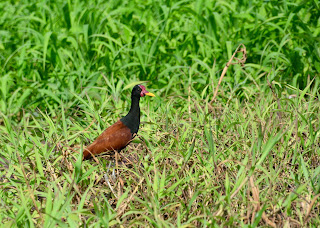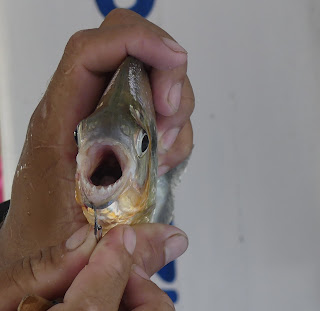Brazil Part 3 – Life at Sea on Seabourn Quest in the Amazon River
March 7, 2023 – Crossing the Amazon River Bar
At 1200 today Seabourn Quest nosed across the Barra Norte, or North Bar of the Amazon River. We are now north of the equator. The bar stretches some 40-50 miles in depth and hundreds of miles in length before the buoyed channel begins and we are in the Amazon River itself. By about 1800 we had passed the two entrance buoys and began the 450 NM trip to Santarem, our first stop. The water has changed to a muddy brown color and we are cautioned to conserve water because the ship cannot make water in the river silt. So, short showers, don’t let the water run while brushing teeth, use towels more than once, etc. Even the whirlpool tubs are on shortened hours.
It is the rainy season still, so the ship encountered many showers, some torrential, and that may continue for our entire trip.
Our days at sea are more relaxed, with later breakfasts, art classes, up to four lectures per day on the history, flora and fauna of the Amazon, various contest activities like Team Trivia, and of course, pool time in between rain showers. There is entertainment in the evenings, with both guest entertainers and the ships entertainment staff with various show productions.
Patrick has a routine of walking on deck 9 for three miles in the morning before breakfast and then 3 more miles after lunch in the afternoon.
We eat most meals at the Patio Grill on the pool deck, where one can get almost anything for breakfast, always a different grilled fish for lunch and an eclectic al fresco dinner in the evening. We sometimes eat at the The Grill by Thomas Keller, a 1950’s chophouse recreation, but the menu is always the same and fairly limited. The main restaurant has a lot of choices every evening, but a more formal (and slower) service. The casual venue is the Colonnade, which we seldom visit since it has a very limited set dinner menu or a buffet which we avoid.
March 8, 2023 – Cruising the lower Amazon River
Overnight Seabourn Quest continued at a fairly slow speed of 8-9 knots until we reached the pilot station at Macapa, some 150 NM upriver. The sun rose about 0615 and the pilots boarded at 0700. The ship picked up speed, now at 15+ knots as we continued upriver to our first destination, Santarem, where the ship will anchor and there will be a variety of shore excursion options. Patrick & Miriam will do a zodiac tour up a tributary near Ponta Negra, and Patrick will do a kayak tour in the same general area. During the day we passed south of the equator are are now back in the Southern Hemisphere.
The expedition team is out on the stern on deck 7 for four hours per day, pointing out wildlife and interesting shore items. The water level is high, and many of the trees are flooded with the rainy season floods in the Amazon. There is an amazing number of small settlements or single houses on stilts along both sides of the river, serviced by a large number of small craft. The ship’s course, following deep water passes as close as 2000 feet from shore, so the views are good.
We have seen mostly vultures, yellow beaked terns and egrets, a few swallows and several species of large butterflies, bumblebees and dragonflies. At the speed we are traveling, not many small insects like mosquitos can keep up, however we later learned some can!
As the day progressed, rain squalls developed and periodically the ship was inundated with warm rain. As the sun set, we had occasional lightning, but surprisingly, could not hear thunder. Our dinner tonight was on the Patio Grill and we were joined by a number of insects attracted to the light, including some looking like crickets, landing in our hair and on the table, but not on the food. It was definitely a unique experience to be thundering along at 15 knots in the dark, up the Amazon, having an open air dinner (but under cover) with occasional rain showers and a variety of flying harmless insects. As darkness fully settled in, the horizon was punctuated by the lights of small communities all around the horizon which were not even visible during daylight hours.
March 9, 2023 – Santarem, Brazil
The ship anchored off the city of Santarem, home to 500,000 people and a major transshipment point for goods like soybeans coming down the Tapacjo River, one of the major tributaries of the Amazon. The Amazon has more than 1400 named tributaries and at least that many unnamed ones.
The zodiac and kayak tours were good, with many sighting of the freshwater pink dolphins, many birds and the giant Victoria Amazonica water lily. The tours included kayaking through the flooded forest and pushing the zodiacs through the grasses and hyacinths clogging the waterways. We saw how many of the locals live in houses built on stilts above the expected high water during flood season when the river is some 30 meters higher and miles wider than during the dry season.
Iguana in the trees
The ship being chased by young man in a long tail boat
March 10, 2023 – Lake Canacari, Brazil
After cruising up the Amazon overnight, at 1430 we anchored off of Lake Canacari, which is connected to the main river by a man made canal. The zodiacs were launched and we headed up the canal to the lake, looking for birds. Instead we found a cayman, small, but with a big splash. There were still more birds and the giant lily’s once again. By the time the zodiac tours were finished, the sun was setting and the last zodiacs came back in the dark.
Local Fisherman
Victoria Amazonica Water Lily
Glittering Throated Emerald Hummingbird feeding
Black Ibis
Red Capped Cardinal
Jacana
Pirahna
Heron
Overnight we had thunderstorms and heavy rains.
March 11, 2023, - Manaus, Brazil
Manaus is the furthest point we will go by ship in the Amazon. Manaus is actually on the Rio Negro and has a populations of 2.5 million. There is a lot of manufacturing in Manaus, including Harley Davidson, Honda and Electrolux, Sony, Samsung, Panasonic, etc, as well as refineries.
In the early morning hours we passed by the “meeting of the waters”, and then anchored in front of the city center. The meeting of the waters is where the Rio Negro meets with the Amazon and the tea colored water of the Rio Negro eventually mixes with the main Amazon river. The cruise terminal pontoon is out of service since one section sank in the fall.
We had arranged a private speedboat tour since all the Seabourn Ventures tours were not allowed to operate by the Brazilian authorities. Our tour went to the same flooded forests as the Ventures tours and it was great.
We are here overnight and Patrick has a Pink Dolphin encounter in the morning. Pink Dolphins are a freshwater dolphin unique to the Amazon basin.
March 12, 2023 – Manaus, Brazil
All too early the alarm sounded and it was time to prepare for the Pink Dolphin Encounter. The location is some 65 KM up the Rio Negro from Manaus and took 90 minutes by high speed boat to reach the floating house where the encounter takes place. The rain was torrential, but the water was warmer than the air. We put on life jackets and stepped down onto a platform about four feet below the water surface. The dolphins came up, rubbed against our legs and pushed against us, and performed for us when fed with fish. We were allowed to touch them, except for the “melon” on the head which contains their sonar. The water has limited visibility, so their eyes are very small. The adults are pink and the youngsters are mostly gray.
We stopped at a local village a few miles away and shopped for local handicrafts before returning to the ship.
At 1730 Seabourn Quest weighed anchor and headed back downstream to our next destination.























No comments:
Post a Comment
Note: Only a member of this blog may post a comment.